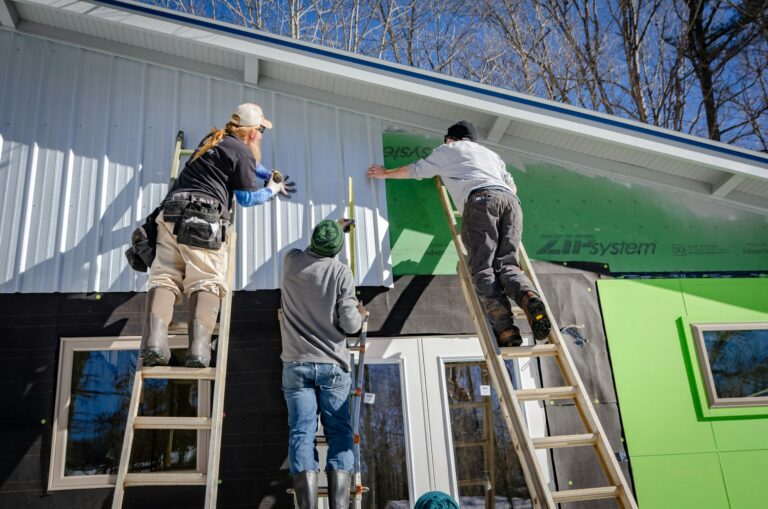
What should I expect during a roof inspection?
A professional roof inspection is a thorough process designed to assess the condition of your roof and identify any potential issues. Here’s what you can expect during a roof inspection:
1. Initial Consultation
- Discussion: The inspector will ask about any known issues, leaks, or previous repairs.
- Documentation: You might provide any relevant documents, such as warranty information or previous inspection reports.
2. Exterior Inspection
- Visual Inspection: The inspector will examine the roof’s overall appearance, looking for obvious damage or wear.
- Shingles: Checking for missing, cracked, curled, or loose shingles.
- Granules: Assessing the loss of granules, which can indicate aging shingles.
- Flashing: Inspecting the metal flashing around chimneys, skylights, and other roof penetrations for rust, damage, or improper installation.
- Valleys: Ensuring the roof valleys are intact and not compromised, as they are critical for water runoff.
- Gutters: Examining gutters and downspouts for blockages, granules, and proper attachment.
- Soffits and Fascia: Checking for signs of rot, damage, or animal intrusion.
- Moss and Algae: Looking for excessive growth, which can indicate moisture problems.
3. Interior Inspection
- Attic Inspection: The inspector will check the attic for signs of leaks, water damage, mold, and proper insulation.
- Ventilation: Ensuring the attic has adequate ventilation to prevent moisture buildup and overheating.
- Roof Deck: Checking for sagging or damage to the roof deck.
4. Detailed Examination
- Seals and Joints: Inspecting the seals and joints around roof penetrations, such as vents and chimneys, for signs of wear or damage.
- Flashing: Closer examination of flashing for potential leaks or corrosion.
- Skylights: Checking the seals and integrity of skylights for potential leaks.
5. Documentation and Reporting
- Photos: The inspector will often take photos of any issues or areas of concern to include in the report.
- Condition Report: A detailed report outlining the condition of the roof, including any damage, potential issues, and areas that may need repair or replacement.
- Recommendations: Suggestions for repairs, maintenance, or replacement, including an estimated timeline and cost.
6. Post-Inspection Consultation
- Review Findings: The inspector will go over the findings with you, explaining any issues and answering questions.
- Next Steps: Discussing the recommended next steps, whether it’s immediate repairs, routine maintenance, or scheduling a replacement.
- Estimates: Providing a cost estimate for any recommended work.
Can I install a new roof over my old one?
Yes, in many cases, you can install a new roof over an existing one. This method is commonly known as a “roof overlay” or “re-roofing.” Here are some key considerations and guidelines for installing a new roof over an old one:
Advantages:
Cost Savings: Re-roofing can be cheaper than a complete tear-off because it saves on labor and disposal costs.
Time Savings: It’s usually quicker to install a new roof over an existing one compared to removing the old roof entirely.
Weather Protection: The existing roof provides temporary weather protection during the installation of the new roof.
Considerations:
Building Codes: Check local building codes and regulations. Some areas may restrict the number of layers of roofing allowed or have specific requirements for roof overlays.
Structural Integrity: Ensure the existing roof structure can support the weight of an additional layer of roofing material. This is particularly important for heavier materials like tile or slate.
Condition of Existing Roof: The existing roof must be in reasonably good condition with no major issues such as extensive water damage, rot, or sagging. Installing a new roof over a damaged substrate can lead to future problems.
Roof Warranty: Some roofing manufacturers may not warranty their products if installed over an existing roof. Check with your roofing manufacturer and installer for specific warranty details.
Aesthetic Considerations: Adding another layer of roofing can increase the height of the roofline, which may affect the appearance of your home.
What are the benefits of metal roofing?
Metal roofing offers several benefits that make it a popular choice for residential and commercial buildings alike. Here are some of the key advantages of metal roofing:
1. Longevity
- Durability: Metal roofs typically last much longer than other roofing materials. They can withstand extreme weather conditions such as high winds, heavy snow, and hail.
- Lifespan: Depending on the material (like aluminum, steel, copper, or zinc), metal roofs can last anywhere from 40 to over 70 years.
2. Low Maintenance
- Minimal Maintenance: Metal roofs require very little maintenance compared to other roofing materials. They are resistant to cracking, shrinking, and eroding.
- Resistance to Elements: They are resistant to mildew, insects, and rot, which can be issues with wood and asphalt shingles.
3. Energy Efficiency
- Reflectivity: Metal roofs reflect solar radiant heat, which can reduce cooling costs in hot climates.
- Insulation: Some metal roofs can be installed with insulation layers that improve energy efficiency by reducing heat loss in cold climates.
4. Lightweight and Installation
- Weight: Metal roofing materials are lightweight compared to other materials like tile or slate, which can reduce strain on the structure of the building.
- Installation: Metal roofs are often easier and faster to install, which can lower labor costs and shorten the duration of construction.
5. Fire Resistance
- Non-combustible: Metal roofs are non-combustible and have a Class A fire rating, which is the highest rating available.
6. Aesthetic Appeal and Variety
- Design Options: Metal roofs come in a variety of styles, colors, and finishes, allowing homeowners to choose an option that complements their home’s architectural style.
- Modern Appearance: They can enhance the curb appeal of a home and give it a modern or contemporary look.
7. Environmentally Friendly
- Recyclable: Metal roofing materials are often made from recycled materials and are fully recyclable at the end of their life.
- Energy Efficiency: Their energy-saving properties can contribute to a building’s overall energy efficiency and sustainability.
8. Resale Value
- Increased Home Value: A metal roof can increase the resale value of a home due to its longevity, durability, and energy efficiency.
Overall, metal roofing is a durable, long-lasting, and energy-efficient option that provides excellent protection for homes and buildings while offering aesthetic versatility and environmental benefits.
What is the difference between roof repair and roof replacement?
Roof repair and roof replacement are two distinct approaches to addressing issues with your roof, each suited to different circumstances based on the severity of damage and the overall condition of the roof :
Roof Repair:
Purpose: Roof repair focuses on fixing specific issues or damage to extend the life of the existing roof.
Scope: It typically involves addressing localized problems such as leaks, damaged shingles, flashing issues, or minor structural damage.
Cost: Generally, roof repairs are less expensive than roof replacement because they involve fixing isolated problems rather than replacing the entire roof.
Timeline: Roof repairs are usually quicker to complete than a full replacement, especially if the issues are isolated and straightforward.
Suitability: Roof repair is suitable when the majority of the roof is in good condition, and the damage is limited to certain areas that can be effectively repaired without compromising the overall integrity of the roof.
Roof Replacement:
Purpose: Roof replacement involves removing the existing roof entirely and installing a new one.
Scope: It is necessary when the roof has reached the end of its lifespan, sustained extensive damage, or if multiple areas of the roof are in poor condition.
Cost: Roof replacement is generally more expensive than repairs due to the labor and materials required to install a new roof.
Timeline: The process of roof replacement is more involved and time-consuming compared to repairs, as it requires stripping off the old roof, preparing the roof deck, and installing new materials.
Suitability: Roof replacement is recommended when the roof is significantly deteriorated, has multiple leaks, shows signs of structural issues, or when the homeowner wants to upgrade to a more durable or energy-efficient roofing material.
How do I prepare my roof for winter?
Preparing your roof for winter is essential to ensure it can withstand the cold temperatures, snow, ice, and potential winter storms. Here are several steps you can take to prepare your roof for winter:
1. Clean Gutters and Downspouts
- Remove Debris: Clear leaves, sticks, and other debris from gutters and downspouts to ensure proper drainage.
- Check for Clogs: Make sure gutters are not clogged to prevent ice dams, which can cause water backup under the roof.
2. Trim Overhanging Branches
- Trim Trees: Cut back overhanging branches that could potentially break and fall onto the roof during heavy snow or ice storms.
3. Inspect and Repair Roof Shingles
- Check for Damage: Inspect roof shingles for cracks, curling, or missing pieces.
- Replace Damaged Shingles: Replace any damaged shingles to prevent leaks and ensure the roof’s integrity.
4. Seal Roof Leaks
- Inspect for Leaks: Check for any signs of leaks in the attic or ceiling and repair them promptly.
- Seal Around Roof Penetrations: Ensure flashing around chimneys, vents, skylights, and other roof penetrations is sealed and in good condition.
5. Insulate and Ventilate Attic
- Check Insulation: Make sure the attic is properly insulated to prevent heat loss, which can contribute to ice dams.
- Ensure Proper Ventilation: Proper attic ventilation helps regulate temperature and moisture levels, reducing the risk of condensation and ice buildup.
6. Check for Structural Issues
- Inspect Roof Structure: Look for signs of sagging or other structural issues that may be exacerbated by heavy snow accumulation.
- Address Any Concerns: If you notice structural issues, consult with a professional roofer for evaluation and repairs.
7. Remove Snow Safely
- Use Caution: If you need to remove snow from the roof, use a roof rake or hire a professional to do it safely.
- Avoid Damage: Be careful not to damage shingles or roofing materials during snow removal.
8. Check and Maintain Skylights and Chimneys
- Inspect and Clean: Check skylights and chimneys for leaks, cracks, or damaged seals.
- Clear Debris: Remove any debris or obstructions around chimneys and ensure skylight seals are intact.
9. Consider Professional Inspection
- Schedule an Inspection: If you’re unsure about the condition of your roof or if it has been a while since the last inspection, consider hiring a professional roofing contractor to conduct a thorough inspection and make necessary repairs.
10. Prepare Emergency Supplies
- Be Prepared: Have emergency supplies handy in case of severe weather, such as heavy snow or ice storms, that could potentially cause roof damage.
By taking these proactive steps to prepare your roof for winter, you can help protect your home from potential damage and ensure a safer and more comfortable environment throughout the cold season.
get in touch.
We’d love to hear from you
Information Request

(403) 708 - 0548
